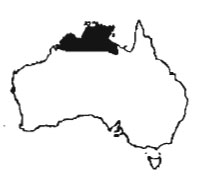Varanus Glebopalma
 |
Twilight goanna.
The twilight goanna is another long-tailed rock-dwelling species. It has a much larger distribution than Glauert's goanna. inhabiting the far north of Western Australia, Northern Territory and Queensland but is absent from the Cape York Peninsula. They also inhabit a number of islands off the northern coast. V.glebopalma is one of the most intriguing of the goannas. They are said to be common in many areas but are rarely seen (e.g. Schmida 1985; Gow 1981). The scientific name of this species refers to the shiny black pads found on the underside of the feet. Its common name is derived from its habit of foraging after sunset, a unique behaviour among varanids (Christian 1977, Shea et al 1988). Although there are records of other species being active occasionally at night (e.g. Auffenberg 1981 for V.komodoensis; Gaulke 1992a for V.salvator) none seem to move regularly during the hours of darkness. The twilight monitor is not exclusively crepuscular and I:an be sighted throughout the day (Valentic 1988).
The twilight goanna reaches a total length of just over 100cm (Storr 1980). The tail is 179246% of the SVL. Average SVL of 43 specimens examined by James et al (1992) was 27.4cm, maximum 34.3cm. They probably attain sexual maturity at around 17cm SVL. Horn & Schurer (1978) suggest that western specimens have longer tails than those from the east. They can be easily distinguished from V.glauerti by the lack of bright bands on the tail, although in very young specimens of V.gleboplama the tail may be completely banded (see Horn & Schurer 1978) adults usually have plain tail tips. Colouration and amount of pattern varies widely, presumably depending on habitat.
The twilight goanna inhabits areas of rock escarpment and large populations may be found in small areas (Christian 1977). Rokylle (1989) considered them to be more common on rocky hillsides with spinifex growth than on the rock outcrops themselves. They are reported to shelter in narrow rock crevices and lie in wait for food on elevated rocks, pouncing on their prey as it passes (Horn & Schurer 1978). All authors comment on the extreme shyness of this species. They react to movement as far as 50m away by dashing for shelter under rocks. Although they can climb vertical rock faces they may be less adept at this than Glauert's goanna (Rokylle 1989). Valentic (1994} reports seeing a twilight goanna chase an agamid over 30 metres of rocky landscape before catching and consuming it. He estimated a speed of over 20km per hour.
Horn & Schurer (1978) speculated that this goanna may feed largely on other lizards. This has been confirmed by analysis of stomach contents of museum specimens (Losos & Greene 19BB; James et al 1992) and by Valentic's observation. Twilight goannas feed mainly on lizards (pygopods, skinks, agamids and varanids (including V.glauerti) and frogs. They also take orthopterans, spiders and centipedes. Breeding probably occurs towards the end of the dry season and the beginning of the wet season (October - January). At least 5 eggs are produced.
In captivity this species is extremely timid and shy. They will accept insects, frogs, lizards and small mammals. Unfortunately I can find no records of captive reproduction. Males are encountered more frequently than females and can be distinguished by the presence of enlarged scales on' either side of the tail base. Basking behaviour is unknown but there are suggestions that this species does not appreciate the very high basking temperatures enjoyed by most other monitor lizards. A large enclosure, furnished with plenty of rocks and stones to provide numerous hiding places, is required to help the animals feel secure. Ideally their diet should contain a mixture of insects and other lizards. Horn & Schurer (1978) report that some individuals refuse to eat mammals.
Attribution / Courtesy: Daniel Bennett. 1995. A Little Book of Monitor Lizards. Viper Press U.K.




